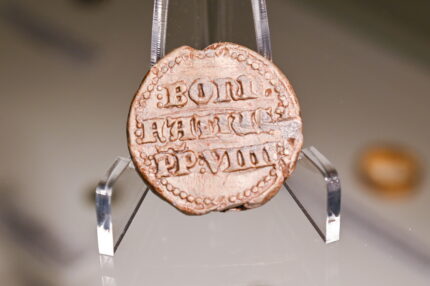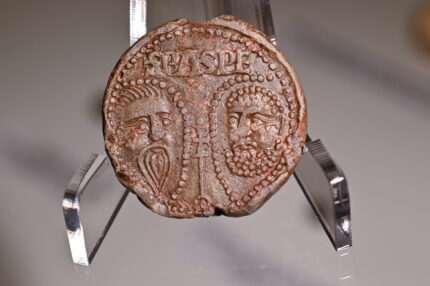 A lead seal found in northwestern Poland has been identified as a rare papal bull from the reign of Pope Boniface IX (1350-1404). It was discovered in 2021 north of a former cemetery in the village of Budzistowo by metal detectorists with the PARSĘTA Exploration and Search Group. Dirt and corrosion made it difficult to identify at first. Specialists in Kraków cleaned and conserved it, revealing the inscription that marks it as the seal of Boniface IX.
A lead seal found in northwestern Poland has been identified as a rare papal bull from the reign of Pope Boniface IX (1350-1404). It was discovered in 2021 north of a former cemetery in the village of Budzistowo by metal detectorists with the PARSĘTA Exploration and Search Group. Dirt and corrosion made it difficult to identify at first. Specialists in Kraków cleaned and conserved it, revealing the inscription that marks it as the seal of Boniface IX.
Bullae were round seals, usually made of lead, that were hung on silk strings affixed to the parchments of official proclamations and documents. They were legally valid and highly recognizable signatures. Metallurgic analysis found that this one was made of pure lead derived from galenite deposits in Cyprus, Sardinia, Greece and Spain. This composition indicates the bull is original, not a later copy.
The reverse inscription reads: BONI/FATIUS/PP:VIIII. The obverse features the images of Saint Peter and Saint Paul identified by the inscription SPASPE above their heads.
In the 9th century, what is now Budzistowo was founded by Pomeranian tribes as the fortified settlement of Kołobrzeg. The settlement was on the Parsęta River 2.5 miles from its mouth on the Baltic Sea, and was rich in salt, fish, iron ore and arable land. The Polish Piast dynasty conquered the area in the 10th century, and Kołobrzeg grew into a regional center of the trade in salt and salt-cured fish.
It became a seat of a bishopric in 1000, but the area would only become thoroughly Christianized in the 12th century. St Mary’s church was built at that time. It was converted into an abbey in the 13th century when German settlers founded a new town of Kołobrzeg on the Baltic and the former Pomeranian stronghold was renamed Old Kołobrzeg. A monastery for Benedictine nuns was then built in Old Kołobrzeg.
 Historians hypothesize that the bull was kept at the Benedictine monastery, based on a reference in the comprehensive history of Kołobrzeg written by the 18th century Pastor Johann Friedrich Wachsen. He recorded that in 1397, Boniface issued a letter of indulgence for the Benedictine nuns. It guaranteed a full indulgence to anyone who visited the local church.
Historians hypothesize that the bull was kept at the Benedictine monastery, based on a reference in the comprehensive history of Kołobrzeg written by the 18th century Pastor Johann Friedrich Wachsen. He recorded that in 1397, Boniface issued a letter of indulgence for the Benedictine nuns. It guaranteed a full indulgence to anyone who visited the local church.
With no relic relating to the monastery surviving to this day, [Dr Robert Dziemba, the head of the Kołobrzeg History Department,] says that if it is proved that this bull is the same one referenced by Wachsen it would be nothing short of “a historical revelation”. […]
Dziemba speculates that this particular papal bull may have been lost in the 16th century.
“After the 1534 congress in Trzebiatów introduced Lutheranism to Pomerania, the document simply lost its value,” he said. “Maybe the bull was thrown out when the duchy took control of the monastery as a result of this congress – but maybe it was lost centuries later. We will probably never know when and why it was discarded.”
The conserved bull has gone on display in the Museum of Arms in Kołobrzeg.